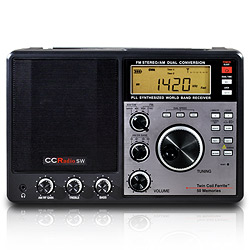Silicon Labs, the chip manufacturer behind some of the best portable shortwave radios in the market (including Tecsun and Grundig) has sold its one billionth DSP radio chip. Silicon Labs has been one of the best things to happen to the portable shortwave market this century. Their DSP chips lower the production cost of radios and enhance the performance with Digital Signal Processing.
I eagerly await the new Tecsun R-2010–an analog radio with the Silicon Labs’ Si483x DSP chip. Not only will it enhance the performance of this basic analog radio, but it should also decrease production costs by as much as 80%!
Here is the full SiLabs press release:
 Industry’s First CMOS “Radio-on-a-Chip” ICs Widely Adopted in Leading Consumer Electronics and Automotive Designs
Industry’s First CMOS “Radio-on-a-Chip” ICs Widely Adopted in Leading Consumer Electronics and Automotive Designs
Reaching a major milestone in the broadcast audio market, Silicon Laboratories Inc [2]. (NASDAQ: SLAB), a leader in high-performance, analog-intensive, mixed-signal ICs, today announced that it has shipped its one billionth broadcast radio IC. Silicon Labs’ digital CMOS broadcast radios are widely used in handsets, portable media players (PMPs), personal navigation devices (PNDs), automotive infotainment systems, tabletop and bedside radios, portable radios, boom boxes and numerous other consumer electronics products.
Silicon Labs introduced the industry’s first single-chip FM receiver in 2005. As the industry’s smallest, highest performance and most integrated FM broadcast radio IC, the Si4700 [3] IC redefined how FM tuners were designed into consumer electronics products. At that time, traditional broadcast audio solutions were based on complex, costly analog architectures that required more than 30 discrete components. The highly integrated Si4700 revolutionized broadcast radio designs by offering exceptional, highly flexible performance, while simultaneously reducing component count by more than 90 percent and board space by more than 60 percent.
Over the past six years, Silicon Labs has rapidly expanded its broadcast audio portfolio [4] to more than 40 distinct products including FM radio receivers, FM radio transmitters/transceivers, AM/FM receivers, shortwave and weather band receivers, RDS data receivers and automotive radio receivers. These products are now the broadcast radio ICs of choice for many leading consumer electronics brands.
“Silicon Labs delivered the industry’s first monolithic all-CMOS FM receiver, providing breakthrough cost, size, integration and performance for broadcast receiver applications in handsets, navigation devices, media players and consumer electronics,” said Jag Bolaria, a senior analyst at The Linley Group. “The company has continued to drive market innovation in CMOS FM transmitters and multi-band AM/FM/SW and weather-band receivers, all widely adopted in the consumer electronics, portable and automotive markets.”
Silicon Labs’ broadcast radio ICs leverage the company’s patented low-IF digital architecture, which enables the highest level of selectivity and sensitivity performance for radios, resulting in reduced interference and superior reception. In addition, Silicon Labs broadcast receivers incorporate advanced audio processing technology that delivers sound quality that is unmatched by other competing radio receiver ICs.
“Silicon Labs thrives on pioneering new ways to solve difficult system design challenges with mixed-signal technology,” said Diwakar Vishakhadatta, general manager of Silicon Labs’ broadcast audio products. “Our single-chip FM, AM/FM receiver and transceiver families are a case in point. These products have helped our customers reduce the cost and complexity of their designs while enabling more features and functionality to help them differentiate their products in the marketplace. We continue to invest and innovate around our low-IF digital architecture to remain a strategic supplier of broadcast radio technology to the industry.”
Silicon Labs has approximately 100 issued and pending worldwide patent applications in audio technologies for its AM and FM related products.
For additional information about Silicon Labs’ broadcast audio products, please visit www.silabs.com/pr/broadcast.
 Many long-time shortwave listeners may find it ironic that the likes of Voice of Russia now broadcasts from a studio in downtown Washington DC. I just read this news article posted on CNN about VOR’s new presence:
Many long-time shortwave listeners may find it ironic that the likes of Voice of Russia now broadcasts from a studio in downtown Washington DC. I just read this news article posted on CNN about VOR’s new presence:
